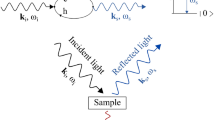Abstract
This is the fourth contribution to an ongoing series of articles entitled ENDPIECE. The idea behind this series is to have a place where the Editor-in-Chief of the journal SILICON can reflect on some aspects of silicon (Si) science and on its applications. Hopefully, the collection of articles will build and the series will serve to show just how broad the field of silicon-based materials and technologies is. Indeed, this broadness is being reflected in the growing content of the journal SILICON. In silicon-based materials, we often use the terms stress and strain in the area of mechanical properties. Seven articles from SILICON have been briefly reviewed herein in order to illustrate the importance of the mechanical testing of silicon-based materials and of the experimental definition of stress and strain. The terms stress and strain have a number of wider definitions and these will be explored. Throughout our daily lives in the modern world we often encounter the word stress and we are all-too-familiar with the negative outcomes of prolonged time periods of being under stress. In this ENDPIECE I will share some of my thoughts and ideas on stress and strain in a broad context. It is worth noting that there are many books available which have stress as (or in) the title. I have used selected topics presented in the popular literature to illustrate various aspects of stress and strain.
Similar content being viewed by others
References
Clarson SJ (2012) Silicon 4:89–91. doi:http://dx.doi.org/10.1007/s12633-011-9096-5
Clarson SJ (2014) Silicon 6:87–8. doi:10.1007/s12633-013-9142-6
Clarson SJ (2009) Silicon 1:57-58-89. doi:10.1007/s12633-009-9009-z
Clarson SJ (2009) Silicon 1:131–136. doi:10.1007/s12633-013-9019-x
Clarson SJ (2010) Silicon 2:105–107. doi:10.1007/s12633-010-9045-8
Clarson SJ (2016) Silicon 8:619–622. doi:10.1007/s12633-016-9442-8
Stevenson A, Waite M (2011) Concise Oxford English Dictionary. Oxford University Press, Oxford, Oxfordshire, OX2 6DP, England. ISBN-13: 978-0-19-960108-0
Clarson SJ (2011) Silicon 3:103–107. doi:10:1007/s12633-011-9093-8
Simmons R (1997) Stress. Element Books Limited, Shaftesbury, Dorset, SP7 8BP, England. ISBN: 1-86204-182-2
Shepherd B (2006) Insight into stress. CWR, Farnham, Surrey, GU9 8EP, England. ISBN-13: 978-1-85345-790-6
Wilkinson G (2006) Understanding stress. Family Doctors Publications and BMA, Poole, Dorset, BH15 1NN, England. ISBN-13: 978-1903474-167
Vibert S (2014) Stress: The path to peace. Inter-Varsity Press, Nottingham, Nottinghamshire, NG7 3HR, England. ISBN-13: 978-1-78539-152-7
Garrido L, Mark JE, Clarson SJ, Semlyen JA (1985) Polym Commun 26:55–57
Lin G, Zhang X, Kumar SR, Mark JE (2009) Silicon 1:173–181. doi:10.1007/s12633-009-9011-5
Puska M, Zhang M, Laattala K, Matinlinna JP, Vallittu PK (2014) Silicon 6:57–63. doi:10.1007/s12633-013-9155-1
Agarwal G, Patnaik A, Sharma RK (2014) 6:155–168. doi:10.1007/s12633-014-9184-4
Fayomi OSI, Popoola API (2015) Silicon 7:49–53. doi:10.1007/s12633-014-9200-8
Meng H, Zhou L (2014) Silicon 6:129–135. doi:10.1007/s12633-013-9170-2
Hjerppe J, Froberg K, Lassila LVJ, Vallittu PK (2010) Silicon 2:171–178. doi:10:1007/s12633-010-9042-y
Clarson SJ, Steinitz-Kannan M, Patwardhan SV, Kannan R, Hartig R, Schlosser L, Hamilton DW, Fusaro JKA, Beltz R (2009) Silicon 1:79–90. doi:10.1007/s12633-009-9018-y
Borel B (2015) Pop Sci 286(3):38–47
Hardwick M (1989) In Studies in Scarlet. Gasogene Press, Ltd., Dubuque, IA 52001, USA ISBN 0-9385501-07-0, pp 13-24
Clarson SJ (1997) ‘A’ Level Textbooks, Sherlock Holmes and the Chemistry Department at the University of York, Grapevine, Autumn/Winter Issue 15:25
Clarson SJ (2016) Silicon 4:5–6. doi:10.1007/s12633-011-9102-y
Acknowledgments
This article was written during the academic year (2015-2016) that I spent on sabbatical at Wycliffe Hall, Oxford, England. I would like to express my gratitude to the faculty and staff in Oxford for facilitating my visit(s) and for being such kind hosts. In particular, I would especially like to thank the Revd. Dr. Michael Lloyd (Principal, Wycliffe Hall) for kindly inviting me to join the thriving Hall community in Oxford as an Academic Visitor for the academic year 2015-2016. I also thank the Revd. Dr. Simon Vibert, the Revd. Dr. Andrew Atherstone, Mr. John Michaux, Ms. Kerstin Jeapes, Ms. Sarah Hope, Ms. Robyn Wyncoll, Ms. Gemma Culverwell, Ms. Trish Coleman and Ms. Kristina Masih for facilitating my visit(s) to Wycliffe Hall. I would like to thank Dr. William D. Hawthorne and Dr. Siddharth V. Patwardhan for providing me with accommodations and with victuals (at short notice) and with good company at the times during 2015-2016 when my travel arrangements in the United Kingdom became somewhat of a challenge. I was experiencing stress in many many many areas of my life during the year 2014. I can state for the record that the grief following the loss of one’s Mother is intense and is prolonged. The kindness and understanding shown to me by my good friends during my grief is a debt that will take me a lifetime to repay.
Author information
Authors and Affiliations
Corresponding author
Additional information
This section of SILICON is named ENDPIECE. It is accompanied by a respectful “thank you” to Roy Hattersley who was the inspiration in my adopting this term for our SpringerNature journal.
Rights and permissions
About this article
Cite this article
Clarson, S.J. Modern Aspects of Stress and Strain. Silicon 9, 465–469 (2017). https://doi.org/10.1007/s12633-016-9511-z
Received:
Accepted:
Published:
Issue Date:
DOI: https://doi.org/10.1007/s12633-016-9511-z




